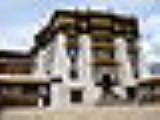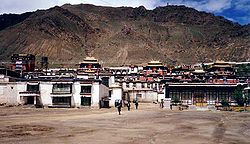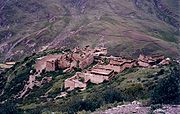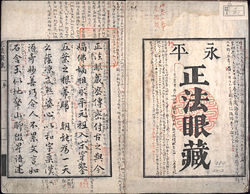
Architecture in Tibet
Encyclopedia

China
Chinese civilization may refer to:* China for more general discussion of the country.* Chinese culture* Greater China, the transnational community of ethnic Chinese.* History of China* Sinosphere, the area historically affected by Chinese culture...
and India
India
India , officially the Republic of India , is a country in South Asia. It is the seventh-largest country by geographical area, the second-most populous country with over 1.2 billion people, and the most populous democracy in the world...
n influences, and reflects a deeply Buddhist approach. The Buddhist Prayer wheel
Prayer wheel
A prayer wheel is a cylindrical "wheel" on a spindle made from metal, wood, stone, leather or coarse cotton. Traditionally, the mantra Om Mani Padme Hum is written in Sanskrit on the outside of the wheel. Also sometimes depicted are Dakinis, Protectors and very often the 8 auspicious symbols...
, along with two deer or dragons, can be seen on nearly every Gompa
Gompa
Gompa and ling are Buddhist ecclesiastical fortifications of learning, lineage and sadhana , located in Tibet, India, Nepal, and Bhutan...
in Tibet
Tibet
Tibet is a plateau region in Asia, north-east of the Himalayas. It is the traditional homeland of the Tibetan people as well as some other ethnic groups such as Monpas, Qiang, and Lhobas, and is now also inhabited by considerable numbers of Han and Hui people...
. The design of the Tibetan Chörtens can vary, from roundish walls in Kham
Kham
Kham , is a historical region covering a land area largely divided between present-day Tibetan Autonomous Region and Sichuan province, with smaller portions located within Qinghai, Gansu and Yunnan provinces of China. During the Republic of China's rule over mainland China , most of the region was...
to squarish, four-sided walls in Ladakh
Ladakh
Ladakh is a region of Jammu and Kashmir, the northernmost state of the Republic of India. It lies between the Kunlun mountain range in the north and the main Great Himalayas to the south, inhabited by people of Indo-Aryan and Tibetan descent...
.
The most unusual feature of Tibetan architecture is that many of the houses and monasteries are built on elevated, sunny sites facing the south, and are often made out a mixture of rocks, wood, cement and earth. Little fuel is available for heat or lighting, so flat roofs are built to conserve heat, and multiple windows are constructed to let in sunlight. Walls are usually sloped inwards at 10 degrees as a precaution against frequent earthquakes in the mountainous area.

World Heritage Site
Standing at 117 meters in height and 360 meters in width, the Potala PalacePotala Palace
The Potala Palace is located in Lhasa, Tibet Autonomous Region, China. It was named after Mount Potala, the abode of Chenresig or Avalokitesvara...
, designated as a World Heritage Site
World Heritage Site
A UNESCO World Heritage Site is a place that is listed by the UNESCO as of special cultural or physical significance...
in 1994 and extended to include to include the Norbulingka area in 2001, is considered a most important example of Tibetan architecture. Formerly the residence of the Dalai Lama
Dalai Lama
The Dalai Lama is a high lama in the Gelug or "Yellow Hat" branch of Tibetan Buddhism. The name is a combination of the Mongolian word далай meaning "Ocean" and the Tibetan word bla-ma meaning "teacher"...
, it contains over a thousand rooms within thirteen stories, and houses portraits of the past Dalai Lamas and statues of the Buddha. It is divided into the outer White Palace, which serves as the administrative quarters, and the inner Red Quarters, which houses the assembly hall of the Lamas, chapels, 10,000 shrines and a vast library of Buddhist scriptures.
Traditional architecture

Kham
Kham , is a historical region covering a land area largely divided between present-day Tibetan Autonomous Region and Sichuan province, with smaller portions located within Qinghai, Gansu and Yunnan provinces of China. During the Republic of China's rule over mainland China , most of the region was...
architecture is seen in most dwellings in Kangding
Kangding
Kangding or Dardo is the name of a county in Garzê Tibetan Autonomous Prefecture in western Sichuan Province, China. It is administrated at the city of Kangding...
. Although the area has been previously heavily logged, wood is imported and used abundantly for housing. Horizontal timber beams support the roof which in turn are supported by wooden columns. The interior of houses are usually paneled with wood and the cabinetry is ornately decorated. In Ganzi
Garzê Tibetan Autonomous Prefecture
Garzê Tibetan Autonomous Prefecture is an autonomous prefecture in Sichuan whose capital is Kangding . It is sometimes spelled as "Kardze" by non-government sources....
, Kham, surrounded by forests, is known for its beautiful wooden houses built in a range of styles and lavishly decorated with wooden ornamentation. Although various materials are used in the well-build houses, it is the skillful carpentry
Carpentry
A carpenter is a skilled craftsperson who works with timber to construct, install and maintain buildings, furniture, and other objects. The work, known as carpentry, may involve manual labor and work outdoors....
that is striking. Khan houses tend to be spacious and fit in well with their environment. Their floors and ceilings are wooden as they are throughout in Kangding. Carpentry is a skill that is passed down from father to son and there appear to be plenty of carpenters. However a threat to the traditional Tibetan carpentry is increasing use of concrete structures. Some consider the increased use of concrete as a deliberate infiltration of the Chinese influence into Tibet. In Gaba Township, where there are few Chinese, almost all the structures are traditional.
Religious architecture


Tashilhunpo Monastery
Tashilhunpo
Tashilhunpo Monastery , founded in 1447 by Gendun Drup, the First Dalai Lama, is a historic and culturally important monastery next to Shigatse, the second-largest city in Tibet....
shows the influence of Mongol
Mongols
Mongols ) are a Central-East Asian ethnic group that lives mainly in the countries of Mongolia, China, and Russia. In China, ethnic Mongols can be found mainly in the central north region of China such as Inner Mongolia...
architecture. Changzhug monastery
Changzhug
Tradruk Temple, also written Changzhug Monastery , in the Yarlung Valley is the earliest great geomantic temple after the Jokhang - and some sources say it is even pre-dates the Jokhang....
is one of the oldest in Tibet, said to have been first built in the 7th century during the reign of King Songsten Gampo (605?-650 CE). Jokhang
Jokhang
The Jokhang, , also called the Qokang Monastery, Jokang, Jokhang Temple, Jokhang Monastery or Zuglagkang , is located on Barkhor Square in Lhasa. For most Tibetans it is the most sacred and important temple in Tibet. It is in some regards pan-sectarian, but is presently controlled by the Gelug school...
was also originally built under Songsten Gampo. Tsurphu Monastery
Tsurphu Monastery
Tsurphu Monastery is a Tibetan Buddhist monastery which served as the traditional seat of the Karmapa. It is located in Gurum town of Doilungdêqên County in the Tibet Autonomous Region of China, 70 km from Lhasa. The monastery is about 14,000 feet above sea level...
was founded by the first Karmapa
Karmapa
The Karmapa is the head of the Karma Kagyu, the largest sub-school of the Kagyupa , itself one of the four major schools of Tibetan Buddhism....
, Düsum Khyenpa
Düsum Khyenpa
Düsum Khyenpa was the 1st Gyalwa Karmapa, head of the Karma Kagyu school of Tibetan Buddhism.Düsum Khyenpa literally means "Knower of the Three times"...
(1110-1193) in 1159, after he visited the site and laid the foundation for an establishment of a seat there by making offerings to the local protectors, dharmapala
Dharmapala
In Vajrayana Buddhism, a dharmapāla is a type of wrathful deity. The name means "Dharma-defender" in Sanskrit, and the dharmapālas are also known as the Defenders of the Law , or the Protectors of the Law, in English....
and genius loci
Genius loci
In classical Roman religion a genius loci was the protective spirit of a place. It was often depicted in religious iconography as a figure holding a Cornucopia, patera and/or a snake. There are many Roman altars found in Western Europe dedicated in whole or in part to the particular Genius Loci...
. In 1189 he revisited the site and founded his main seat there. The monastery grew to hold 1000 monks. Tsozong Gongba Monastery
Tsozong Gongba Monastery
Tsozong Gongba Monastery is a small sacred chapel of the Nyingma tradition of Tibetan Buddhism .-Symbolism:...
is a small shrine
Shrine
A shrine is a holy or sacred place, which is dedicated to a specific deity, ancestor, hero, martyr, saint, daemon or similar figure of awe and respect, at which they are venerated or worshipped. Shrines often contain idols, relics, or other such objects associated with the figure being venerated....
built around 14the century A.D. Palcho Monastery
Palcho Monastery
The Palcho Monastery or Pelkor Chode Monastery or Shekar Gyantse is the main monastery in Gyantse, Gyangzê County, Shigatse Prefecture, Tibet, in the Nyangchu river valley...
was founded in 1418 and known for its kumbum
Kumbum
A Kumbum is a multi-storied aggregate of Buddhist chapels in Tibet. It forms part of Palcho Monastery.The first Kumbum was founded in the fire-sheep year 1427 by a Gyantse prince. It has nine lhakangs or levels, is 35 metres high surmounted by a golden dome, and contains 77 chapels which line...
which has 108 chapels on its four floors. Chokorgyel Monastery
Chokorgyel Monastery
Chokorgyel Monastery is a Buddhist monastery in Gyatsa County in Tibet.-History:In 1509 Gedun Gyatso, the 2nd Dalai Lama, had a meditation cave and founded a hermitage here...
, founded in 1509 by Gendun Gyatso, 2nd Dalai Lama
Gendun Gyatso, 2nd Dalai Lama
Gendun Gyatso Palzangpo , also Gendun Gyatso was the second Dalai Lama....
once housed 500 monks but was completely destroyed during the Cultural Revolution
Cultural Revolution
The Great Proletarian Cultural Revolution, commonly known as the Cultural Revolution , was a socio-political movement that took place in the People's Republic of China from 1966 through 1976...
.
Ramoche Temple
Ramoche Temple
Ramoche Temple is a Buddhist monastery is considered the most important temple in Lhasa after the Jokhang Temple. Situated in the northwest of the Tibetan capital of Lhasa, it is east of the Potala and north of the Jokhang, covering a total area of 4,000 square meters .-History:Ramoche is...
is an important temple in Lhasa. The original building complex was strongly influenced by Tang Dynasty
Tang Dynasty
The Tang Dynasty was an imperial dynasty of China preceded by the Sui Dynasty and followed by the Five Dynasties and Ten Kingdoms Period. It was founded by the Li family, who seized power during the decline and collapse of the Sui Empire...
architectural style as it was first built by Han Chinese architects in the middle of the 7th century. Princess Wencheng
Princess Wencheng
Princess Wencheng was a niece of the powerful Emperor Taizong of China's Tang Dynasty, who left China in 640, according to records, arriving the next year in Tibet to marry the thirty-seven year old Songtsän Gampo the thirty-third king of the Yarlung Dynasty of Tibet, in a marriage of...
took charge of this project and ordered the temple be erected facing east to show her homesickness.
Monasteries such as the Kumbum Monastery
Kumbum Monastery
Kumbum Monastery is a Buddhist monastery in Qinghai province, China. Kumbum was founded in 1583 in a narrow valley close to the village of Lusar in the Tibetan cultural region of Amdo. Its superior monastery is Drepung, immediately to the west of Lhasa...
continue to be affected by Chinese politics. Simbiling Monastery
Simbiling Monastery
Simbiling Monastery, also known as Shambuling Gompa, Shepeling Dzong and Taklakot Gompa, was located next to the large fort of Tegla Kar on a ridge near Taklakot, above the town of Purang, in the Ngari province, which is just over the border from Nepal in western Tibet in the valley of the Karnali...
was completely flattened in 1967, although it has to some degree been restored. See List of Tibetan monasteries.

